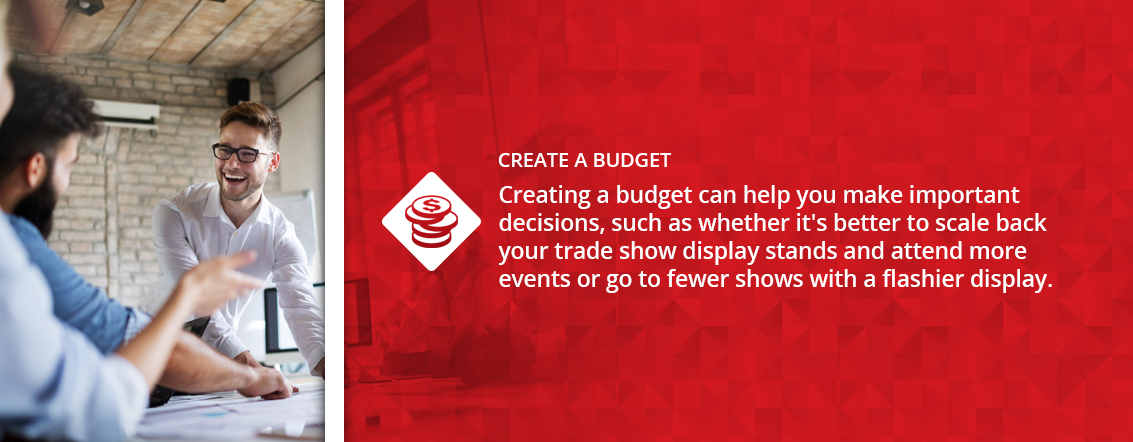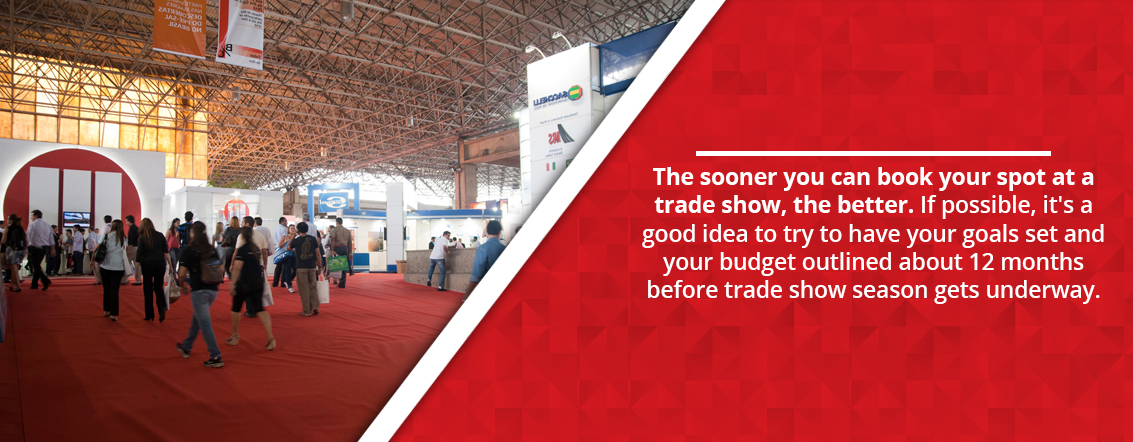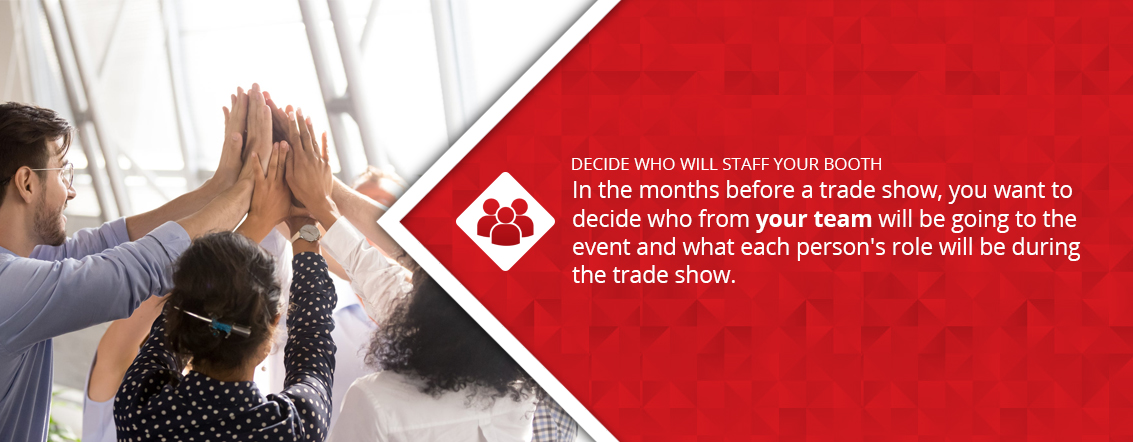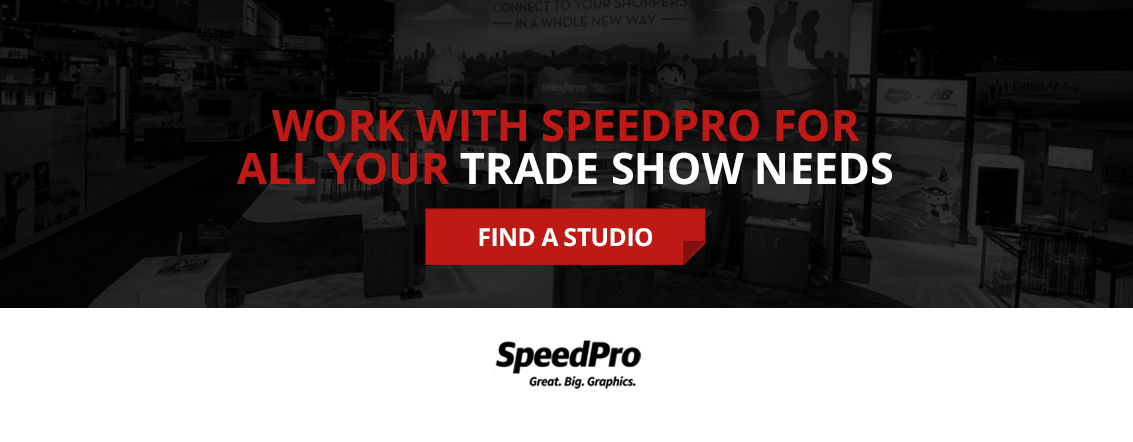
The Ultimate Trade Show Marketing Checklist
JANUARY 20, 2020| SpeedProAttending trade shows gives you the chance to connect with new clients, reconnect with past clients and learn about what’s new in your industry. If you’re going to exhibit at a trade show, there is a fair amount of work involved in getting ready for the event and making your booth stand out in a sea of other exhibitors and vendors.
Prepping trade show displays isn’t something to leave to the last minute. If possible, start planning for your next in-person event at least one year in advance. We’ve put together a checklist to help you get started with the planning process and to help you make sure you’ve dotted every “i” and crossed every “t” before the show begins, during the event and afterward.
What to Do Before the Trade Show
As you prep for a trade show, it’s a good idea to set deadlines for yourself and your team. Many shows will give you a calendar of due dates when you register so that you know when you need to provide certain information to the event’s organizers. Beyond that, it can be helpful to make up your own deadlines for tasks, such as defining your goals and putting together a budget. That way, you can feel confident that you’re ready to go and that everything is in order as the date of the trade show approaches.
1. Set Your Goals
The first thing to do when prepping for trade shows is to set goals and objectives. What do you hope to get out of going to these shows and how will you know if you’ve reached your goals? Ideally, the goals you set will be ones you can trace and measure, such as:
- Generate X number of new leads.
- Gain X number of new followers on social media.
- Make X number of sales within X amount of time after the show.
- Connect with X number of potential investors.
- Collect resumes from X number of qualified candidates.
- Increase email or newsletter subscription rate by X%.
It’s possible to have multiple goals for the same trade show or to set different goals for different events. For example, you might participate in a show that’s designed for industry insiders. In that case, it would make more sense for your goals to focus on finding new employees or new investors rather than on increasing sales. For events that are open to the public or to clients in your industry, focusing on sales-related goals will make more sense.
2. Create a Budget
After your goals, your budget is the most important thing to consider when preparing trade show graphics. Your overall budget determines how many trade shows you can attend, how far away those shows are and how elaborate your custom trade show exhibits can be. Creating a budget can help you make important decisions, such as whether it’s better to scale back your trade show display stands and attend more events or go to fewer shows with a flashier display.
Some of the costs to consider when putting together your trade show budget include:
- Cost to purchase or rent trade show booth materials.
- Cost to purchase custom marketing materials.
- Cost of travel to and from the trade show venue.
- Cost of food and hotels during each trade show.
- Vendor or exhibitor fees charged by the trade show.
- Cost of employee wages or overtime, if necessary.
- Cost of booth set-up, breakdown, transportation and storage.
3. Reserve Your Spot
The sooner you can book your spot at a trade show, the better. If possible, it’s a good idea to try to have your goals set and your budget outlined about 12 months before trade show season gets underway. That way, you can start booking the shows you want to participate in as soon as registration opens.
Why reserve your spots early? The sooner you book, the more say you’ll have when it comes to the location of your booth at an event. Ask the event organizers for a map of the exhibit area, so that you can clearly see the routes and entrances in the exhibition hall.
Even if you don’t get to choose the exact location of your booth, having the event’s layout in hand will help you as you work on designing your display. You might place certain signs or displays in areas that will have more traffic than others, such as the side of your booth that faces an entrance to the exhibition hall or the side that’s opposite the restrooms or lounge area.
4. Design Your Booth
Once you know where you’ll be situated during a trade show, it’s time to get to work designing your booth. If you have materials left over from previous trade shows, you can reuse them during the upcoming trade show season. If you rented materials in the past, you can rent again and can change things up as you see fit. Some things to consider as you design your booth include:
- The size of your booth: How much space do you have to work with? Will you be able to set up different areas for attendees to check out, such as a seating area with reading material or wall display with digital graphics? Can you hang things from the ceiling or other vertical spaces?
- Lighting options: The more well-lit your booth, the more visible it will be to passersby. Think about the areas that you want to highlight, then add lights to them if possible. For example, you might add a row of LED lighting under a banner or use color-changing lights to draw attention to a poster or video display.
- Interactive materials: If possible, include interactive materials in your booth design. Interactive materials, such as video programs, tablets with touchscreens or demos of your newest products, give people something to do while they are waiting to speak with someone from your team. Interactive materials can also make your booth more attractive to people who might otherwise stroll by.
5. Prep Your Marketing Materials
If you’re going to use custom-printed marketing materials as part of your trade show display, you’ll want to make sure that you have the designs finalized several months before the first event. It’s also a good idea to decide what type of materials you’re going to need. For example, if you’re going to exhibit at trade shows that take place outside, it’s a good idea to bring along an event tent. An event tent provides coverage from the sun and protection from the rain. It also helps to get your message and brand logo out there.
Although event tents are most commonly used during outdoor shows and programs, you might use one at an indoor event, too. Setting up a tent inside can make your booth seem more novel. The logos printed on the top of the tent can also make your booth more visible and help people find your brand across a crowded exhibition floor.
In addition to event tents, trade show booth signage other marketing materials to design and order as you put together your exhibit include:
- Banners
- Tabletoppers
- Digital signage
- Floor decals
- Corporate marketing signage
- Brochures and other print materials
6. Decide Who Will Staff Your Booth
In the months before a trade show, you want to decide who from your team will be going to the event and what each person’s role will be during the trade show. Deciding who’s going and who will stay behind far in advance will ensure that your company has the coverage it needs back at headquarters.
Another reason to pick your trade show team well in advance is that doing so gives you time to order uniforms or matching T-shirts as well as time to put together a plan. A trade show is an opportunity for you to take advantage of the particular strengths of your employees. If you know that one team member is great at bringing people in and making them feel welcome, that employee will definitely be someone you want to have greeting attendees at the event. If you know that another member of your team does an excellent job when it comes to closing the sale and getting people to purchase or hand over their contact information, then that’s another person you want working with you.
When you’re picking who will go and who will stay, it’s a good idea to look back at your budget. Depending on where the trade show is located, how you’ll get there and how many nights you need to stay in a hotel, you might only be able to bring a limited number of employees. For local events, you can bring more members of your team. In fact, you could even ask employees to attend the trade show as participants, then report back any interesting findings to you.
7. Confirm Travel and Other Last-Minute Details
As the day of the trade show gets closer and closer, it’s time to focus on last-minute details. If you need to fly to get to the trade show, it’s a good idea to book your tickets at least three weeks in advance, if not earlier. In some cases, you can get a better deal if you book your hotel and flights at the same time.
Once you’ve figured out how your team will get to the event and where they will stay while there, it’s time to think about how your graphics and booth will get to the trade show. Depending on the size of the booth, you might be able to bring it with you on the flight as checked luggage. If that’s not feasible, you may have to pay to ship the materials to the trade show or hire a truck or van and drive the display there yourself.
It’s also a good idea to put together a plan for the trade show and to review what everyone will say or do while at the booth. You might want to make rules for your team, such as no sitting while in the booth, to keep the energy up. It’s also important to make sure everyone has a clear idea of their roles and responsibilities.
Also, review how your team will handle expenses while at the trade show. Should employees save their receipts from meals for reimbursement later on or will you give them company credit cards to use? Another thing to think about is whether or not you’ll have petty cash on hand to cover incidentals.
8. Scope out the Competition
About a week or so before the show, take a look at who else will be exhibiting. While you probably won’t get a preview of your competitor’s booths, it can be helpful to know who is going to be at the event.
What to Do During the Trade Show
Finally, the day of the trade show has arrived and you and your team are getting ready to meet and greet attendees. Here’s what you can do throughout the show to run smoothly and make sure you reach your goals.
1. Get Everyone on the Same Page
Although you probably reviewed roles and responsibilities with your team in advance of the trade show, now that the time of the event has arrived, it can be worthwhile to sit down with everyone and make sure you all understand your company’s goals and what each person will be doing.
Depending on how things go at the trade show itself, you might need to make adjustments on the fly. If it’s a multi-day event, it can be a good idea to schedule daily check-ins to see how people are doing and to get a sense of if things are working.
2. Use Social Media or the Event App to Your Advantage
Don’t shy away from technology during a trade show. Use it to get the word out about your booth and to connect with people at the event. If the trade show has an app, have each member of your team download it and use it. The app can help you see who’s who at the trade show and can keep you up to date on any changes that might come up at the last minute.
There are lots of ways you can use social media during a trade show. You can follow people you meet at your booth right away, you can post details about any giveaways or contests you’re running, and you can share videos and photos of your booth.
3. Hold Giveaways
Make your trade show exhibit the place people want to be by holding giveaways or contests throughout the event. While plenty of people are going to get excited about the chance to win, it’s also important that you make your giveaways worthwhile for your company. For example, instead of holding a random raffle, where you draw an anonymous, numbered ticket, hold a business card drawing. That way, you get to collect contact information from future customers.
4. Hand out Swag
Some people go to trade shows just for the free stuff they can collect from vendors and exhibitors. Giving out freebies can be a two-way street. A trade show attendee gets to walk away from a free T-shirt or stress ball, and your company gets another chance to get its logo out into the world.
It can be helpful to choose your freebies wisely. While some are inexpensive, such as pencils or pens, they are also aren’t particularly visible. If you want your message and branding to be visible and seen throughout an event, give out swag that’s a little more “in your face.” Tote bags are great since people can use them to carry their belongings and other freebies throughout the show. If you give out totes, your logo will be hanging in full view from the shoulders of hundreds of attendees.
5. Give People Something to Do
Depending on how popular your booth is, there might be times during the event when there are more visitors to it then staff members to talk to them. To keep people hanging around your booth as long as possible, it’s important to give them something to occupy their time. Some booth activities that can be worthwhile include:
- Games, such as slot-machine style games or other games of chance.
- Interactive surveys on a tablet.
- Videos describing your product or company’s history.
- Demos of your product for people to play with or sample.
- Reading material such as brochures or glossy magazines about your brand.
What to Do After the Trade Show
The end of a trade show is a time to reflect on what happened and to make a plan for future events. It’s also a good time to follow up on any leads and to evaluate your results, to see if you reached your goals.
1. Follow up With Leads
The sooner you follow up with leads after a trade show, the better. You want your brand to be fresh in people’s minds, and you want people to still be excited about the chance to work with you. If possible, follow up within a week of the event.
Try to follow up with leads with a personal message. A phone call can be ideal, as it gives you a chance to speak to the person directly. Sending a personalized email is another option, but keep in mind that many people feel overwhelmed by their inbox and might not respond. Some people also have filters in place that sift anything that seems promotional into a separate folder, where they might not see it at all.
When you follow up with people, have a plan. Give them options and the chance to move forward with your company. For example, you can suggest that they schedule an in-person meeting or sales call. In some cases, you might convince them to make a purchase during the follow-up call.
2. Review Your Budget
It’s also a good idea to take another look at your budget at the end of a trade show. You want to see if your total expenses were in line with what you were expecting or if you ended up going over budget. If the latter, you might find that you need to adjust for future shows. For example, if travel and hotels ended up costing more than planned, you might take one or two fewer employees next time.
It might also be that you came in under budget and have money left over to use for a future trade show. Decide what you’ll do with any “extra” funds, such as investing that money in more bells and whistles for your booth or enhancing the giveaways you offer at your next event.
3. Track Your Progress
Keep focused on your goals in the weeks and months after the trade show. You want to keep tracking your leads, conversions and other metrics. If your goal was to find more investors, pay attention to how much money you raised in the first couple of quarters after the show. If you hoped to find new, qualified team members during the event, keep track of which candidates apply for a position with your company as a result of attending the trade show.
4. Check-in With Your Team
It’s also a good idea to touch base with the team members who attended the show with you, to get an idea of what they thought about it. Hold a debriefing meeting once you’re all back in the office. Topics to discuss at the meeting include:
- Their favorite part of the trade show.
- What they thought worked.
- What they thought didn’t work.
- What they might do differently next time.
5. Start Planning Your Next Trade Show
Knowing what you now know, it’s time to start thinking about your next event or trade show. Most likely, you’ll keep what worked during the last program and make adjustments to things that were challenging or that didn’t turn out as planned. Once your first show of the trade show season is over, it’s never too early to get started planning the second, third and subsequent shows.
Work With SpeedPro for All Your Trade Show Needs
Whether you’re in the process of designing a trade show exhibit booth from scratch or are looking for guidance when it comes to tabletop marketing materials and digital displays, SpeedPro has you covered. We’ll work with you to help you create the materials you need to stand out at a trade show and to achieve your goals. To get started, find the SpeedPro studio nearest you today.




















![Booth Design Tips [list]](https://www.speedpro.com/wp-content/uploads/2020/02/5-Design-Your-Booth.jpg)


![What to do During the Trade Show [list]](https://www.speedpro.com/wp-content/uploads/2020/02/8-What-to-Do-During-the-Trade-Show.jpg)
![What to do After the Trade Show [list]](https://www.speedpro.com/wp-content/uploads/2020/02/9-What-to-Do-After-the-Trade-Show.jpg)
